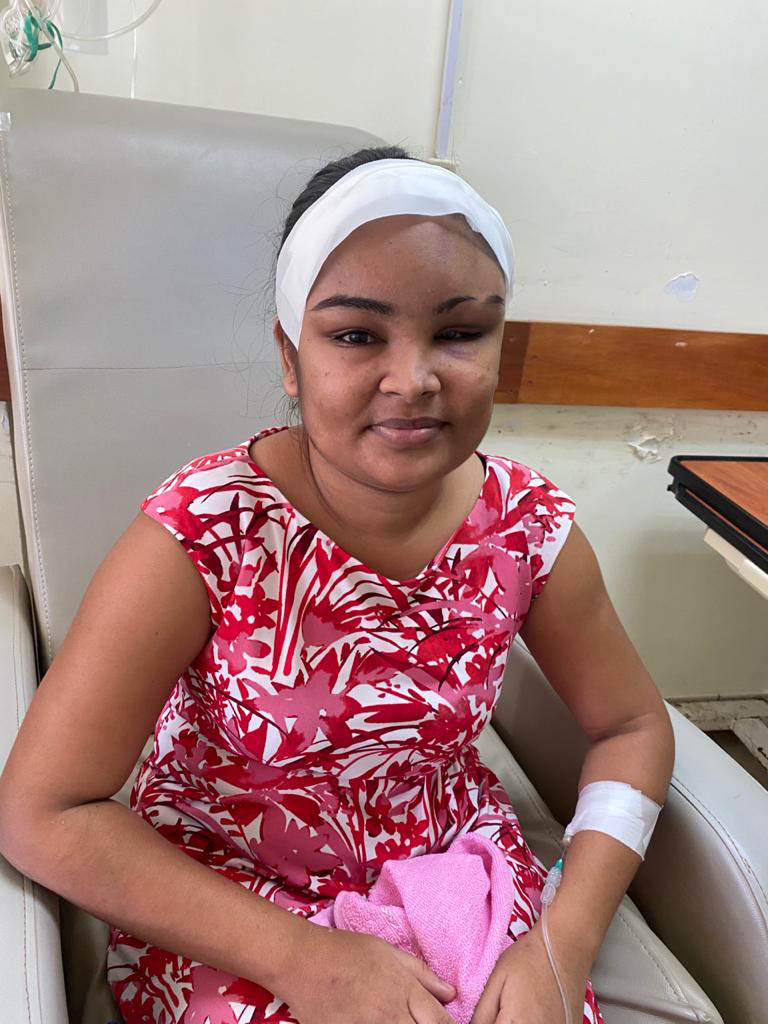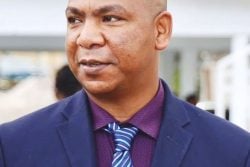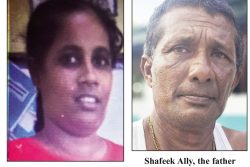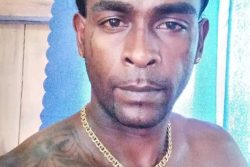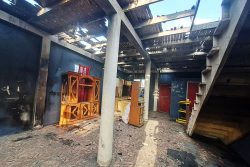A team of doctors on Saturday successfully performed Guyana’s first skull transplant giving a 23-year-old single parent a new lease on life.
The surgery which lasted for six hours was performed at the St Joseph Mercy Hospital (SJMH) by a team of doctors led by neurosurgeon Dr Amarnauth Dukhi. It would have cost approximately US$20,000 for it to be done overseas.
The patient, Analisa Latchman, a mother of one of Lima, Essequibo Coast secured US$11,000 to pay for the skull implant.
The skull implant was acquired from KLS Martin Group of the US, using funds from a GoFundMe campaign which was set up to assist Latchman.
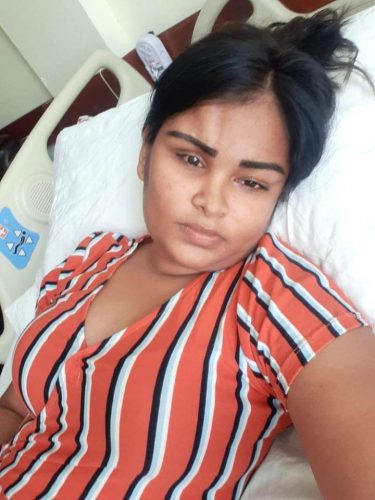
Dr Dukhi offered to perform the surgery free of cost and the hospital charges were underwritten by businessman Chris Fernandes.
The surgery was done in partnership with NeuroSpine Services Inc, a company based at St Joseph Mercy Hospital that offers specialised advanced brain and spinal care in Guyana.
Latchman is recovering well and is expected to be discharged sometime between today and tomorrow morning.
At a press conference hosted yesterday at the St Joseph Mercy Hospital boardroom, Chief Executive Officer (CEO), Dr Dukhi said that the surgery is historic due to the fact that it’s a first-world procedure that was done in a developing third-world health sector.

“We were able to complete that procedure without any difficulty. For this to be done, it was a tedious process where the most minute detail had to be set up and put into place to avoid any difficulty during the procedural aspect of this patient’s intervention,” Dr Dukhi said.
Latchman was diagnosed with cranial facial fibrous dysplasia in July during her first consultation with Dr Dukhi.
According to the Mayo Clinic website, fibrous dysplasia is an uncommon bone disorder in which scar-like (fibrous) tissue develops in place of normal bone. It states that the irregular tissue can weaken the affected bone and cause it to be deformed or to fracture.
Fibrous dysplasia can affect any bone in the body but most commonly affects bones in the skull, ribs and thigh.
“My first impression was that she was suffering from a cranial facial dysplasia. After I had a detailed look into the scan and comparatively looked into her, how her frontal lobes are, which was a healthy right side and more or less sick left side of her head. I was able to detect that this is a patient that had one of the rare cranial facial disorders. So the diagnosis of Analisa then was what we call a cranial facial fibrous dysplasia,” Dr Dukhi explained.
He said the issue/disease occurs in 1 to 5 out of every 30,000 people that are born. “So we are looking anything about 10 to 15 in every 100,000 babies that are born… The thing that I thought that with the epilogical review of this case, Analisa fits perfectly into what we normally call a classical diagnosis for these type of issues,” Dr Dukhi added.
First ever
According to Dr Dukhi, not only was the surgery the first ever of this kind but Latchman was also the first person to have been diagnosed in Guyana with this disease.
Dr Dukhi said a decision was made to have the surgery done here following a discussion with the Latchman family. “I spoke to them and I listened to what was happening and it was really painful to see a young lady with a small child suffering so much and headaches by itself, they are very intense. It has an effect on how you carry on your routine daily activities, etc. I told them listen, you guys find a way to pay for the implant, we are going to source it, we are going to have it constructed and I will offer my services pro bono,” Dr Dukhi disclosed.
During the surgery, forty per cent of Latchman’s skull was removed and replaced.
Dr Dukhi explained that a 3D reconstruction of Latchman’s skull was sent to KLS Martin Group in order to construct the implant to suit her face. “We spoke to the family and they were saying the most initial aspect of this thing was to create a replacement for 40 per cent of Analisa’s skull. So I did a CT scan, I reconstructed the 3D and realised that almost 40 per cent of Analisa’s skull was sick. That structure of her skull vault has now become fibrous and it was pulling her face structure into the brain hence why she had an asymmetric facial look where her left side went to the brain and the right side of her face was where it should be.”
“So eventually after connecting them, they asked for a 3D reconstruction of Analisa’s head. We were able to send that to KLS Martin and they actually reconstructed the 40 per cent of deficit that we would have provoked during surgery in Analisa’s head. That was amazing because, one, it’s very difficult to do it without actually seeing the patient but thanks to technology and CT scans and MRI, etc, this is now possible. Because we have these resources in Guyana, it’s important that we use them and we use our human resource capacity as we continue to develop health care both in the public and the private sector,” he further explained.
The problem with the reconstruction/ replacement of Latchman’s skull, Dr Dukhi said, was that it involved three bones. “It involved the frontal bone, the parietal bone, and the temporal bone of the left side of her head. Three of our major issues and her symptoms was due to the involuting or the convoluting reduction of her skull which was squeezing her front lobe,” he related.
The frontal lobe, according to Dr Dukhi is responsible for behavioural pattern and is also one of the lobes that provokes what is called the Jacksonian type of seizures.
Latchman was likely to have suffered permanent brain damage if the surgery was not done. “So she was likely to have permanent brain damage over the next couple of years… she more than likely would have had ischemic changes to the brain due to continuous compression from an involuting or the convoluting skull vault,” Dr Dukhi said.
“… a very technical surgery because we had to go all the way to the eye and the orbit. Imagine part of her eyes at the back is now into her brain. We were able to reset her orbit back to where it was so if you look at Analisa now she will actually have a nice looking forehead not that indented forehead anymore. Her orbit is back in place. She has good vision. It was tedious for me because they have two very important nerves that come out right around the area where I have to work which is the facial nerve and the upper branch of the trigeminal nerve. We were able to dissect that very carefully away and protect it, so there were no injuries to her nerve,” Dr Dukhi explained.
The implant arrived in Guyana last Thursday.
Latchman is expected to lead a normal life. “…..I am seeing that clinical response now from Analisa. She is walking, she is eating… I don’t foresee any complications for Analisa and I do see her now having a normal life. No issues at all in terms of how we take it into the future. Her headache has already subsided. I am very hopeful and very confident that in moving forward Analisa should be fine and she should go back to a privileged life which we all supposed to live,” Dr Dukhi assured.
“Severe, excruciating headaches”
Speaking to reporters yesterday from her hospital room, Latchman said that that she is doing great and was no longer experiencing any headaches.
“I am doing good, no headaches. It feel really good because I have been suffering with headaches so long and since I do the surgery I am not getting it,” she said.
Prior to her diagnosis, Latchman worked as a sales representative at a store.
She is hoping to return to work soon so that she can take care of her daughter. “Once I fully recover I will start working again because I am a single parent and I have my daughter to take care of. Special thank you to Dr Dukhi because I have visited so many doctors and I got no help but at the first visit to Dr Dukhi, he told me about my surgery,” Latchman added.
Meanwhile, Dr Sarah Lall Khan, Latchman’s cousin, who was present during the press conference explained that she and Latchman spent most of their childhood together. At the age of ten, she said, they observed an indentation in her forehead. “It was just an indentation. As kids, we had no idea. We thought that’s just how she is, that’s just the way she was born.”
At that point in time, she noted that Latchman had no symptoms. However, as she grew, Khan said, the indentation became more “pronounced”. “… and we also noticed that her left eye started receding inward.”
According to Khan, Latchman then started to experience severe headaches. “Severe to the point, [where] absolutely nothing was helping.”
Initially, Latchman thought that it was her eyes so she visited an ophthalmologist about six to eight weeks ago. “So he had a look at the eye. He told her she had good vision in the eye, although the eye has receded, it is not affecting her vision in anyway,” Khan related.
She said Latchman then told her that the ophthalmologist requested a CT scan. “So when she contacted me, I told her fine. We are going to have the CT scan done. The CT scan showed a little bit of abnormalities with her eye.”
Khan said because Latchman was experiencing so much headaches, she advised her that it is best to visit the neurologist. “So we can actually treat the headaches since nothing was actually wrong with her eyes,” Khan said.
She explained that Latchman visited the neurologist and also consulted with another ophthalmologist at the Georgetown Public Hospital (GPH). “Just to have an idea and see exactly what was causing this,” Khan said.
The neurologist, according to Khan asked Latchman to have an MRI done. “Which we did. However, we kept going back to the neurologist, there wasn’t nothing to work with really. She was also suggesting that we have further tests done. However, Analisa still continued with these headaches. Severe, excruciating headaches to the point where further on she started to have loss of consciousness,” Khan further explained.
“So you know I told her ‘Analisa I think this is getting worse and our last option, our only hope I think is for us to go see Dr Dukhi. Let’s go to him and see what’s really going on’. Because all we were doing is treating the pain, we really haven’t found the cause of the pain. We don’t have a diagnosis to work with and we just taking pain medications one after the other and it’s really not helping,” she added.
On the first visit to Dr Dukhi, Latchman was diagnosed. “Well we bought all of our scans and everything. I spoke to him. Told him her history and he listened to us and he had one look at the scan and when he looked at the scan, I didn’t even give him the reports for the scan… when he looked at the scan he was able to diagnose on the spot exactly what was wrong with Analisa,” Khan recalled.
“Honestly, I was so impressed because taking Analisa from one person to the other, I was feeling so hopeless for her because I really wasn’t helping her. All I was doing was trying to find help. We went to Dr Dukhi, he diagnosed her and of course came up with a treatment plan on our very first consultation,” she noted.
